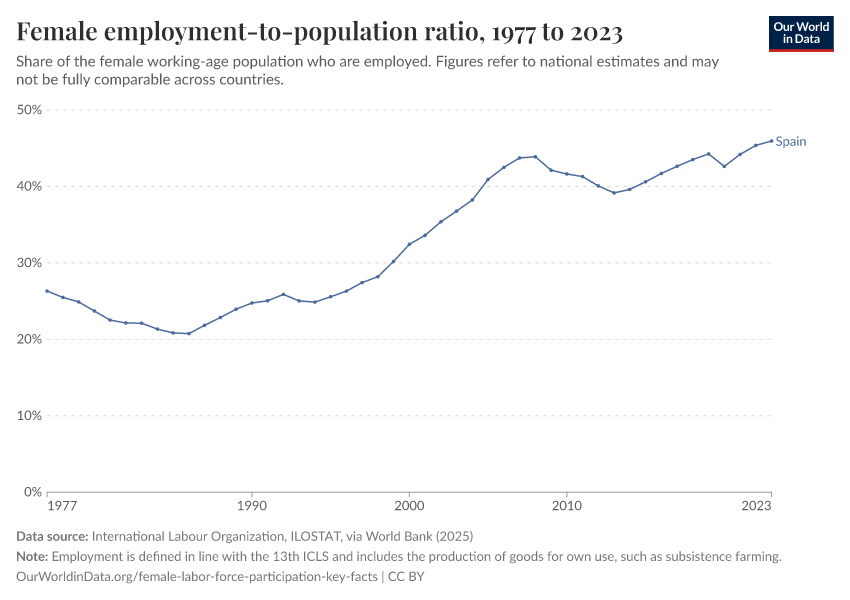Female employment-to-population ratio

What you should know about this indicator
- This indicator is defined as the proportion of a country’s working-age population that is employed. Employment refers to people who worked for at least an hour during the reference period (typically a week), whether in paid employment or self-employment. This indicator gives a broad sense of how many people in a country are working, regardless of the kind of job they have or how many hours they work.
- When defining the labor force, the working-age population includes all people above the legal working age for employment in each country. The ILO’s guidelines define it as people aged 15 and older, but national definitions vary, depending on local laws. Some countries also set an upper age limit.
- This data comes from national sources, typically labor force surveys, household surveys, or population censuses. Each country uses its own definitions and methods, so this data may not be directly comparable across countries and over time.
- This data follows the standards of the 13th International Classification of Labour Statisticians (ICLS). Under this framework, employment includes work for pay or profit, including self-employment, as well as the production of goods for own use (such as subsistence farming). Changes in the definition of employment also affect who is counted as unemployed or outside the labor force. Because definitions were updated under the 19th ICLS, data using the newer definitions is not fully comparable with data based on the 13th ICLS. You can read more about the definitions in this explainer by the ILO.
Related research and writing
What you should know about this indicator
- This indicator is defined as the proportion of a country’s working-age population that is employed. Employment refers to people who worked for at least an hour during the reference period (typically a week), whether in paid employment or self-employment. This indicator gives a broad sense of how many people in a country are working, regardless of the kind of job they have or how many hours they work.
- When defining the labor force, the working-age population includes all people above the legal working age for employment in each country. The ILO’s guidelines define it as people aged 15 and older, but national definitions vary, depending on local laws. Some countries also set an upper age limit.
- This data comes from national sources, typically labor force surveys, household surveys, or population censuses. Each country uses its own definitions and methods, so this data may not be directly comparable across countries and over time.
- This data follows the standards of the 13th International Classification of Labour Statisticians (ICLS). Under this framework, employment includes work for pay or profit, including self-employment, as well as the production of goods for own use (such as subsistence farming). Changes in the definition of employment also affect who is counted as unemployed or outside the labor force. Because definitions were updated under the 19th ICLS, data using the newer definitions is not fully comparable with data based on the 13th ICLS. You can read more about the definitions in this explainer by the ILO.
Sources and processing
This data is based on the following sources
How we process data at Our World in Data
All data and visualizations on Our World in Data rely on data sourced from one or several original data providers. Preparing this original data involves several processing steps. Depending on the data, this can include standardizing country names and world region definitions, converting units, calculating derived indicators such as per capita measures, as well as adding or adapting metadata such as the name or the description given to an indicator.
At the link below you can find a detailed description of the structure of our data pipeline, including links to all the code used to prepare data across Our World in Data.
Reuse this work
- All data produced by third-party providers and made available by Our World in Data are subject to the license terms from the original providers. Our work would not be possible without the data providers we rely on, so we ask you to always cite them appropriately (see below). This is crucial to allow data providers to continue doing their work, enhancing, maintaining and updating valuable data.
- All data, visualizations, and code produced by Our World in Data are completely open access under the Creative Commons BY license. You have the permission to use, distribute, and reproduce these in any medium, provided the source and authors are credited.
Citations
How to cite this page
To cite this page overall, including any descriptions, FAQs or explanations of the data authored by Our World in Data, please use the following citation:
“Data Page: Female employment-to-population ratio”. Our World in Data (2025). Data adapted from Labour Force Statistics (LFS) – ILOSTAT, via World Bank. Retrieved from https://archive.ourworldindata.org/20251110-093756/grapher/female-employment-to-population-ratio.html [online resource] (archived on November 10, 2025).How to cite this data
In-line citationIf you have limited space (e.g. in data visualizations), you can use this abbreviated in-line citation:
Labour Force Statistics (LFS) – ILOSTAT, via World Bank (2025) – processed by Our World in DataFull citation
Labour Force Statistics (LFS) – ILOSTAT, via World Bank (2025) – processed by Our World in Data. “Female employment-to-population ratio – ILO” [dataset]. Labour Force Statistics (LFS) – ILOSTAT, via World Bank, “World Development Indicators 122” [original data]. Retrieved December 5, 2025 from https://archive.ourworldindata.org/20251110-093756/grapher/female-employment-to-population-ratio.html (archived on November 10, 2025).